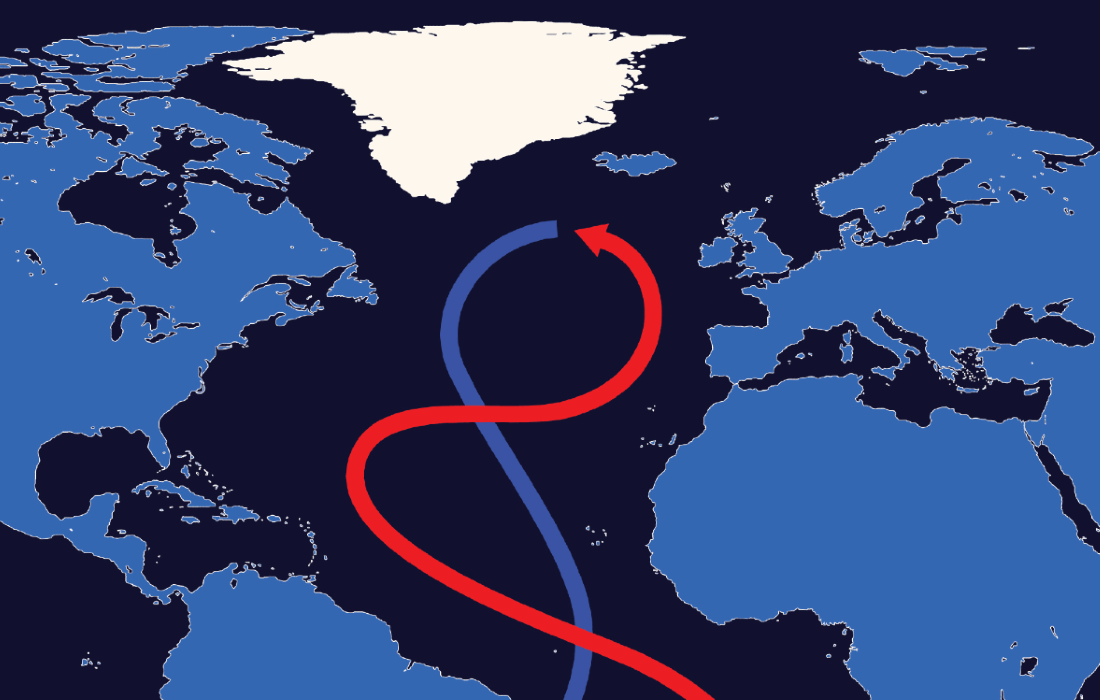Gloomy climate calculation: Scientists predict a collapse of the Atlantic ocean current to happen mid-century
Important ocean current that redistribute heat, cold and precipitation between the tropics and the northernmost parts of the Atlantic region will shut down around the year 2060 if current greenhouse gas emissions persist. This is the conclusion based on new calculations from the University of Copenhagen that contradict the latest report from the IPCC.

Contrary to what we may imagine about the impact of climate change in Europe, a colder future may be in store. In a new study, researchers from the University of Copenhagen’s Niels Bohr Institute and Department of Mathematical Sciences predict that the system of ocean currents which currently distributes cold and heat between the North Atlantic region and tropics will completely stop if we continue to emit the same levels of greenhouse gases as we do today.
Using advanced statistical tools and ocean temperature data from the last 150 years, the researchers calculated that the ocean current, known as the Thermohaline Circulation or the Atlantic Meridional Overturning Circulation (AMOC), will collapse – with 95 percent certainty – between 2025 and 2095. This will most likely occur in 34 years, in 2057, and could result in major challenges, particularly warming in the tropics and increased storminess in the North Atlantic region.
"Shutting down the AMOC can have very serious consequences for Earth's climate, for example, by changing how heat and precipitation are distributed globally. While a cooling of Europe may seem less severe as the globe as a whole becomes warmer and heat waves occur more frequently, this shutdown will contribute to an increased warming of the tropics, where rising temperatures have already given rise to challenging living conditions," says Professor Peter Ditlevsen from the Niels Bohr Institute.
"Our result underscores the importance of reducing global greenhouse gas emissions as soon as possible," says the researcher.

The calculations, just published in the renowned scientific journal, Nature Communications, contradict the message of the latest IPCC report, which, based on climate model simulations, considers an abrupt change in the thermohaline circulation very unlikely during this century.
Early warning signals present
The researchers' prediction is based on observations of early warning signals that ocean currents exhibit as they become unstable. These Early Warning Signals for the Thermohaline Circulation have been reported previously, but only now has the development of advanced statistical methods made it possible to predict just when a collapse will occur.
The researchers analysed sea surface temperatures in a specific area of the North Atlantic from 1870 to present days. These sea surface temperatures are "fingerprints” testifying the strength of the AMOC, which has only been measured directly for the past 15 years.
"Using new and improved statistical tools, we’ve made calculations that provide a more robust estimate of when a collapse of the Thermohaline Circulation is most likely to occur, something we had not been able to do before," explains Professor Susanne Ditlevsen of UCPH’s Department of Mathematical Sciences.
The thermohaline circulation has operated in its present mode since the last ice age, where the circulation was indeed collapsed. Abrupt climate jumps between the present state of the AMOC and the collapsed state has been observed to happen 25 times in connection with iceage climate. These are the famed Dansgaard-Oeschger events first observed in ice cores from the Greenlandic ice sheet. At those events climate changes were extreme with 10-15 degrees changes over a decade, while present days climate change is 1.5 degrees warming over a century.
About the study:
The work is supported by TiPES, a joint-European research collaboration focused on tipping points of the climate system. The TiPES project is an EU Horizon 2020 interdisciplinary climate research project focused on tipping points in the climate system.
Furthermore, funding was provided by Novo Nordisk Foundation; and European Union’s Horizon 2020 research and innovation program under the Marie Skłodowska-Curie grant agreement, “Economic Policy in Complex Environments (EPOC).
Contact
Peter Ditlevsen
Professor
Niels Bohr Institute
University of Copenhagen
Mobile: +45 28750603
Mail: pditlev@nbi.ku.dk
Susanne Ditlevsen
Professor
Department of Mathematical Sciences
University of Copenhagen
Mobile: +45 41127789
Mail: susanne@math.ku.dk
Kristian Bjørn-Hansen
Journalist and Press Contact
Faculty of Science
University of Copenhagen
+45 93 51 60 02
kbh@science.ku.dk
Michael Skov Jensen
Journalist and team coordinator
The Faculty of Science
University of Copenhagen
Mobile: + 45 93 56 58 97
Mail:msj@science.ku.dk
